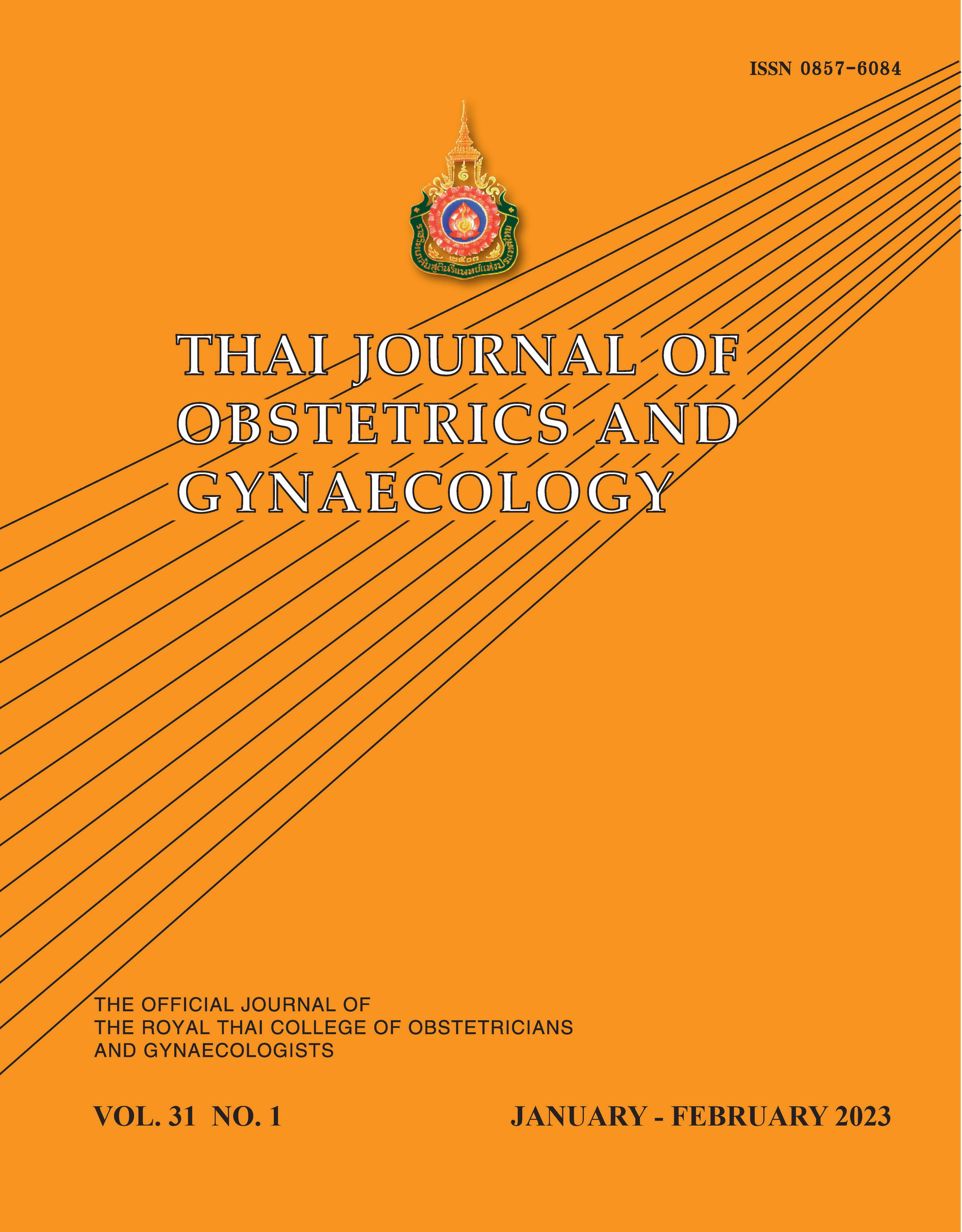Lidocaine Prilocaine Cream versus Intracervical Injection for Pain Relief during Loop Electrosurgical Excision Procedure
Main Article Content
Abstract
Objectives: To compare the effectiveness between lidocaine prilocaine cream versus intracervical injection for pain relief during loop electrosurgical excision procedure (LEEP).
Materials and Methods: Sixty women who underwent LEEP at Khon Kaen Hospital were enrolled in a single, blinded, non-inferiority randomized controlled trial. The participants were randomly allocated into two groups; group 1 received lidocaine prilocaine cream applied to the cervix (n = 30), and group 2 intracervical injection (n = 30) before performing LEEP. The pain score was measured at speculum placement, during anesthetization, during the procedure, immediately after, and 30 min after the procedure, using the 10-cm visual analogue scale (VAS). In addition, we recorded adverse events and additional analgesia.
Results: Baseline characteristics were similar between groups. The mean pain score during LEEP among groups was not significantly different between intracervical injections (control group) (5.53 ± 0.46, 95% confidence interval (CI) 4.60-6.47 vs. 4.59 ± 0.44, 95%CI 3.68-5.50, p = 0.145). The mean pain score during anesthetization with lidocaine prilocaine cream (intervention group) was significantly lower than with the intracervical injection (1.20 ± 0.29, 95%CI 0.60-1.80 vs. 3.62 ± 0.48, 95%CI 2.64-4.60, p < 0.001). No serious adverse events occurred.
Conclusion: Lidocaine prilocaine cream was not significantly different intracervical injection for pain relief during LEEP and provided better pain relief during anesthetization (than in the control group) without serious adverse events.
Article Details

This work is licensed under a Creative Commons Attribution-NonCommercial-NoDerivatives 4.0 International License.
References
Prendiville W. Large loop excision of the transformation zone. Clin Obstet Gynecol 1995;38:622-39.
Jiang YM, Chen CX, Li L. Meta-analysis of cold-knife conization versus loop electrosurgical excision procedure for cervical intraepithelial neoplasia. Onco Targets Ther 2016;9:3907-15.
Wright TC Jr., Gagnon S, Richart RM. Treatment of cervical intraepithelial neoplasia using the loop electrosurgical excision procedure. Obstet Gynecol 1992;79:173-8.
Harper DM, Walstatter BS, Lofton BJ. Anesthetic Blocks for Loop Electrosurgical Excision Procedure. J Fam Pract 1994;39:249-56.
Tangsiriwatthana T, Duangkum C, Suwunnapang S. Cervical spray versus intracervical injection in loop electrosurgical excision procedure: a randomized controlled trial. J Gynecol Surg 2013;29:241-4.
Lipscomb GH, McCord ML, Bain KW. The effect of topical 20% benzocaine on pain during loop electrosurgical excision of the cervix. Am J Obstet Gynecol 1995;173:772-4.
Vanichtantikul A, Charoenkwan K. Lidocaine spray compared with submucosal injection for reducing pain during loop electrosurgical excision procedure: a randomized controlled trial. Obstet Gynecol 2013;122:553-7
Ljunghall K, Lillieborg S. Local anaesthesia with a lidocaine/prilocaine cream (EMLA) for cautery of condylomata acuminata on the vulval mucosa. The effect of timing of application of the cream. Acta Derm Venereol 1989;69:362-5.
Van der Burght M, Schønemann N, Laursen J, Arendt-Nielsen L, Bjerring P. Duration of analgesia following application of eutectic mixture of local anaesthetics (EMLA) on genital mucosa. Acta Derm Venereol 1993;73:456.
Liberty G, Gal M, Halevy-Shalem T, Michaelson-Cohen R, Galoyan N, Hyman J, et al. Lidocaine–Prilocaine (EMLA) cream as analgesia for hysterosalpingography: a prospective, randomized, controlled, double blinded study. Hum Reprod 2007;22:1335-9.
Arnau B, Jovell E, Redón S, Canals M, Mir V, Jiménez E. Lidocaine-prilocaine (EMLA®) cream as analgesia in hysteroscopy practice: a prospective, randomized, non-blinded, controlled study. Acta Obstet Gynecol Scand 2013;92:978-81.
Zilbert A. Topical anesthesia for minor gynecological procedures: a review. Obstet Gynecol Surv 2002;57: 171-8.
Zullo F, Pellicano M, Stigliano C, Di CC, Fabrizio A, Nappi C. Topical anesthesia for office hysteroscopy. A prospective, randomized study comparing two modalities. J Reprod Med 1999;44:865-9.
Tavakolian S, Doulabi MA, Baghban AA, Mortazavi A, Ghorbani M. Lidocaine-prilocaine cream as analgesia for IUD insertion: a prospective, randomized, controlled, triple blinded study. Glob J Health Sci 2015;7:399.
Williams LK, Weber JM, Pieper C, Lorenzo A, Moss H, Havrilesky LJ. Lidocaine-prilocaine cream compared with injected lidocaine for vulvar biopsy. Obstet Gynecol 2020;135:311-8.


